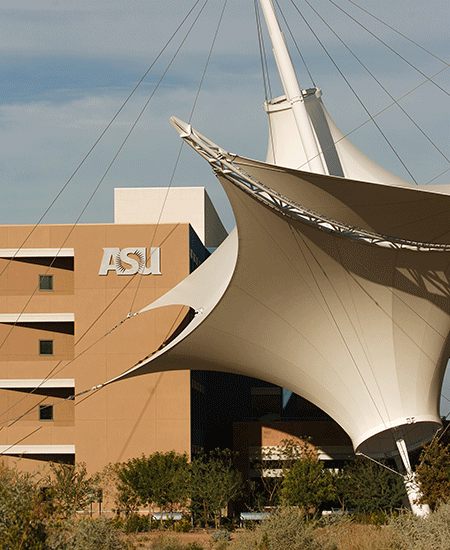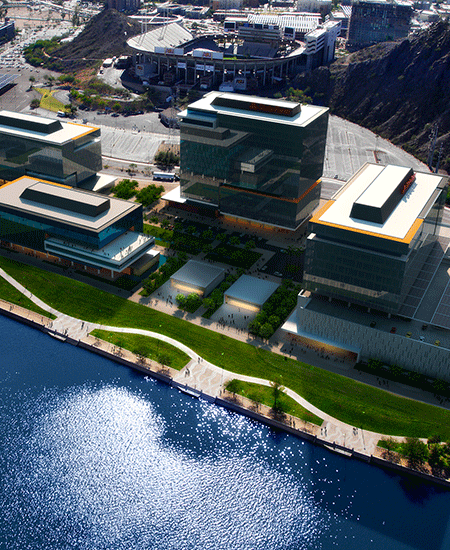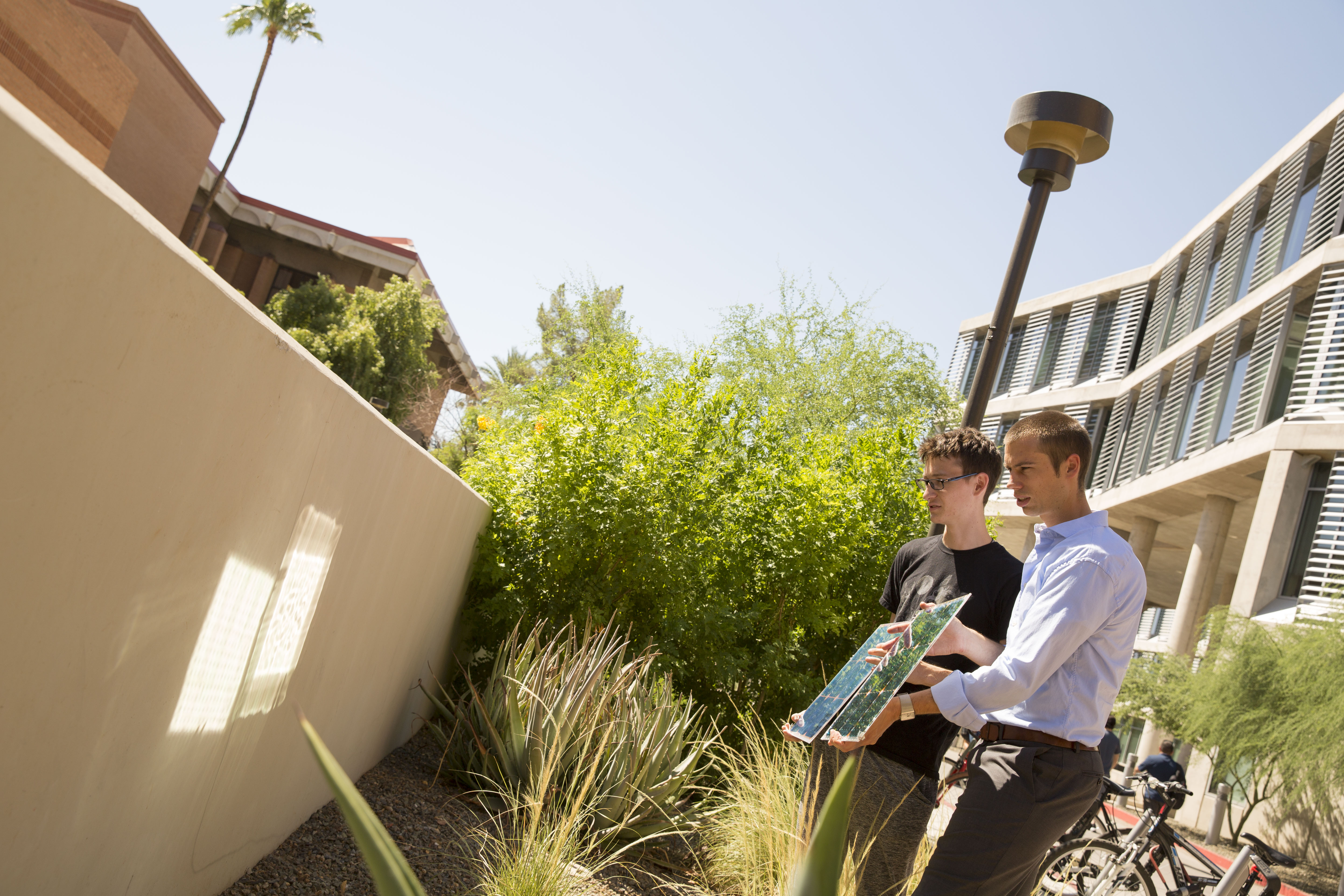Editor's note: This story is being highlighted in ASU Now's year in review. Read more top stories from 2018 here.
Engineering created modern Phoenix.
More than 500 years ago, the Hohokam excavated about 500 miles of canals so crops could be grown in the desert. The current 131-mile-long canal system is almost entirely laid out on top of the ancient network. Roosevelt Dam was built to hold spring runoff and control the Salt River so it didn’t whip around the Valley floor like a snake in a shoebox. And, although not invented in Arizona, Willis Carrier’s air conditioning made the area attractive to millions after World War II.
Engineering turned one of the most inhospitable places on Earth into the fifth-biggest metropolitan area in the country, and engineering research — when it’s paired with industry — will continue to transform the Valley of the Sun’s future.
As human knowledge doubles every 13 months, change happens faster and faster. Greater Phoenix is uniquely positioned to seize upon discoveries that are happening at Arizona State University, especially at the nation’s largest engineering school with more than 450 faculty and researchers in six multidisciplinary schools. Companies can benefit from a relationship with the university as innovations and advancements move outward.
“Unsurprisingly, where there’s a hot research field, there’s also a serious interest to an industry,” said Kyle Squires, dean of the Ira A. Fulton Schools of Engineering.
Academia and industry have different strengths. They complement each other, but they also cancel out each other’s weaknesses. A huge part of science is poking around in the dark, seeing what works and what doesn’t. Businesses simply can’t afford to run into too many dead ends before the money runs out.
“We’re allowed to go try things which are probably going to work, but often don’t, and that’s OK,” said ASU Associate Professor Dan Bliss, director of the Center for Wireless Information Systems and Computational Architectures. “Certainly in industry some startups do this, but it is problematic because you invest a fair amount of money and you make a mistake, and you don’t get to do that too many times.

"What I see on the horizon is we need to have economic development and the university aligned to induce more Arizona-based (intellectual property) to be generated,”
said Chris Camacho, president and chief executive officer of the Greater Phoenix Economic Council.
“You have to explore lots of ideas before you find the right ideas to work, so academia and ASU in particular is well-suited to doing these sorts of research tasks. Cooperation and teaming between ASU and various industrial entities would provide just the right combination of skills to complement each other,” added Bliss.
From basic research to developing an idea for a solution all the way through to commercialization and delivery to the market is a huge space. On one end you have academics trying to identify early solutions. At the other end are companies. Because of time and budget constraints, industry can impart its innate sense of urgency to academia.
“What industry can provide academia is more than capital and a conduit to deliver solutions,” said William Tyler, associate professor of biological and health systems engineering.
Besides ideas and research, industry gains other advantages by working with a university.
Benchmark Electronics designs and manufactures electronics. When they began the search for a new home, the organization had a number of criteria. An affordable cost of living, solid infrastructure and a world-class airport were all important, but the company moved to the Phoenix area specifically to be near ASU. Company leaders wanted proximity to a major university that was willing to collaborate and work with them.
Chief Executive Officer and President Paul Tufano said of the benefits: “ASU surpassed our expectations. What does that mean? When I think about that, I think about it on three different levels. Clearly having a student population that is obviously well-educated and trained and will be a pipeline for our engineering development needs is critical. We established two new design centers, one in high-speed circuit design and (radio frequency) and another in (internet of things) integration, and so our ability to be close to a research institution that allowed us to advance those things, as well as the potential to get faculty to work with us and/or some of their grad students, we found that to be very beneficial.”
Explore: A map showing clusters of engineering-related employment around Greater Phoenix
Right now there are 318 companies looking at the metro Phoenix market. What all have in common is a craving for bright minds, said Chris Camacho, president and chief executive officer of the Greater Phoenix Economic Council, the region’s leading economic development organization. The nonprofit assists businesses interested in coming to the Valley.
Tech companies need the university talent pipeline to drive research and development outcomes. They “want to be more engaged with our post-secondary system so we can drive more commercializable (intellectual property) here in greater Phoenix,” Camacho said. “Industry relies on higher education more than ever.”
Camacho continues, “Even broader than talent, it’s now about university alignment on research, and ensuring that we have technology road maps that are embedded within companies. We need universities that are nimble enough and value-add enough to drive existing research capabilities to the next stage to ultimately help companies grow and scale research development.”

"Our ability to be close to a research institution that allowed us to advance, as well as the potential to get faculty to work with us ... we found that to be very beneficial,” said Paul Tufano, CEO and president of Benchmark Electronics. Photo by Tom Story/ASU
Brains and visions of the technologies that will exist decades in the future are what industry wants and what ASU can provide in spades.
“We’re an engineering college,” Squires said. “Our most valuable commodity that we produce for people outside are graduates who can go in and do things. They’ll go into Honeywell, Intel, Raytheon, Medtronics — you can go down the list — but increasingly into small startups, the new companies that are attracted here and you have young talent with the right skill set to take a nascent, really interesting, beginning-to-thrive entrepreneurial culture and get it to the next level. I think that’s important for our future here.”
Ideas, via research, are the other valuable commodity produced on campus.
“We need to not only think about the technologies that drive near-term innovation but also look 15 to 20 years into the future,” said Squires. “As I love to point out, if you don’t have faculty advancing the foundational research ideas that identify where a given field is going to be 20 years from now, you’re never going to get there. Impact occurs across the entire spectrum — from blue-sky thinking that takes the long view to technology advances over the near-term that are critical to enhancing competitiveness.”
John Graham has a bird’s-eye view of the Valley. The president and CEO of Sunbelt Holdings — a real estate development and investment company — Graham chairs the Partnership for Economic Innovation, a collective of community leaders dedicated to fulfilling regional economic opportunities. He also sits on the boards of a number of Valley institutions. He said ASU’s efforts to partner with industry are paying off, but unheralded.
“What I’ve seen, especially under the leadership of Dean Squires, is really a strong effort to reach out to the business community and to the technology infrastructure that’s in our community to find more collaborative ways to work together, not only with the impressive growth of the engineering school online and in the classroom, but the fact that through his efforts he has reached out so intentionally and effectively to the rest of the community,” Graham said.
“I think a lot of people, for whatever reason, don’t know that this is going on or that it’s available. ASU is making it much more user-friendly for the outside to reach in and figure out both how to access important things at ASU and work with the school, so I think it’s something that the more it’s talked about, the more specific relationships that are talked about, the better it is for everybody.”
With some 350 tenured/tenure-track faculty, the Fulton Schools of Engineering covers a very broad area of research strengths. Here are the five areas with significant growth potential for ASU and for the Valley.
Growth area 1: Wearable technologies
Health care is beginning to look to engineering as heavily as it has looked to organic chemistry. In the future, health care will involve something you put on as much as it will swallowing a pill. That may take the form of a blood-pressure monitor you wear on your wrist or a necklace to conquer insomnia, the latter being one of Tyler’s inventions.
Tyler explains the idea of wearable tech: “You have the choice as a consumer — Do you want to try this (external device) to relieve pain and anxiety, or do you want to go have your back cut open and have some electrodes put in? You have the choice. This one costs $200, and the other $30,000.”
Getting from concept to market — what Tyler calls the Valley of Death — with wearable technologies can take as long as 48 months. Pharma has a really big Valley of Death, because of all the testing and the safety and the unknowns and the targets.
“Because (wearables) are safe, you can iterate really quickly on testing cycles,” Tyler said. “It’s like, ‘Hey look, we developed this solution.’ We’re going to test it in 10-15 people, hint of the concept, develop that through proof of concept, and then you can start to span that Valley of Death much quicker. That’s really where wearables have an advantage, because you can deliver solutions to the market much faster.”
Growth area 2: Internet of things
“When you take a look at the explosion of radios with which we interact every day, this is going to be a big deal for industry,” Bliss said. “Currently on my body I have eight radio systems on me. Every device we interact with has multiple radio systems that interact with everything else.”
This is a significant opportunity for industry, because of the sheer number of devices that will exist.
“The telecom industry now exceeds $1.6 trillion. If you take a look at the number of human users, we’re over a billion now,” Bliss said. “When you take a look at the path to expansion, it’s going to be mostly nonhuman users. These are all the internet of things devices. Those in industry that figure out how to provide the capabilities we want are going to be the winners. And financially it’s going to be a big deal.”
Growth area 3: Automation and robotics
Spring Berman is an assistant professor of mechanical and aerospace engineering who studies the modeling, analysis, control and optimization of robotic swarms.

"ASU is making it much more user-friendly for the outside to reach in and figure out both how to access important things at ASU and work with the school,” said John Graham, president and CEO of Sunbelt Holdings. Image courtesy of Sunbelt Holdings
“Automation and robotics promises to increase productivity and efficiency for a lot of industries,” Berman said. “Another advantage is that the robots can be used for tasks that are repetitive or dangerous or could be hazardous for a person to do.
“There’s a lot of effort not only in developing the robots themselves and the technologies, but also understanding how they can interact with human operators to get the best of both worlds, so the uniquely human capabilities of supervision and decision-making and the fact the robot can do repetitive tasks can increase productivity and human comfort.”
Growth area 4: Water innovation
In a 2017 survey of 1,500 companies, 95 percent said water is important — and they were not getting any help with it, said Paul Westerhoff, an ASU Regents’ Professor and vice dean for research and innovation for the Fulton Schools.
“None of the companies had a really good idea actually how much water affected the bottom line of the product,” said Westerhoff. “One of the needs is to clearly understand the value of water in manufacturing, to quantify that for different sectors — how much they rely upon it — and what is their vulnerability to water disruption.”
Almost all these companies treat water onsite because tap water isn’t of high enough quality for those such as hospitals, restaurants and semiconductor manufacturers. They face the same problems consumers do at home: scaling due to hardness, high salt content and unpleasant tastes and odors. Cooling towers use more water than necessary and sensors become fouled, for example.
“If these companies can come to an area where there are other companies going through similar experiences — 95 percent of these respondents said they wish they had a forum to exchange ideas at a professional level across different sectors,” Westerhoff continues. “We can create that forum at ASU, and that will attract companies who care about water conservation and industrial water purification. I think we can expand the types of companies that are located in Arizona ... we are already recognized as being pretty forward leaders in Arizona around water management.”
Growth area 5: Renewable energy
ASU has the largest solar research facility in the country. It is the only university in the U.S. where you can make a full-size, commercial solar cell. Solar companies send their researchers to work with faculty in the labs.
“Solar in particular is an excellent growth area because there is suitable local expertise (in the form of the semiconductor industry) for solar module manufacturing; a unique solar research center (the Quantum Energy and Sustainable Solar Technologies center, or QESST, at ASU) producing the best-trained graduates in the country; and intense sunlight in Arizona that drives local demand,” said Zachary Holman, an assistant professor of electrical engineering.
Christiana Honsberg, director and principal investigator at QESST, said collaboration is key.
“Photovoltaics is the poster child for how technology should be done — collaboratively, working with industry and in concert with educators,” she said. “We have an opportunity to demonstrate that solar is beneficial to society. It’s not about having the next paper published in Nature.”
Assistant Professor Zachary Holman (right) and Professor Yong-Hang Zhang (not shown) have crated a monocrystalline cadmium telluride solar cell that could result in more efficient solar panels worldwide. Photo by Jessica Hochreiter/ASU
Aligning the economy, university
ASU has been innately entrepreneurial over the last decade. Now, regional economic development and the university need to align more closely, GPEC’s Camacho said.
“What I see on the horizon is we need to have economic development and the university aligned to induce more Arizona-based (intellectual property) to be generated,” he said. “That’s having public resources to support industry-led innovation centers and technology dispositions for things like wearable technologies, health sciences, personalized medicine and even advanced electronics playing to our legacy industry strengths of microelectronics.
“That’s where I see the intersection of applied research between universities and economic development, and then, by supporting ideation and the commercialization of those ideas, we will successfully drive our future generation of companies.”
These industry/academia partnerships are working, and they’re working successfully, Graham said.
“I think the best economic development story in the state — for sure the city — has been ASU under the regime of Dr. (ASU President Michael) Crow,” he said. “I think part of why that’s the case is that he’s done a brilliant job of reaching out to the community, in his words ‘embedding’ ASU into the community. (A partnership between industry and the engineering schools) is front and center of that type of relationship and part of the reason that ASU and the community have been so successful in those areas.”
It has been successful for Benchmark Electronics, and Tufano expects it to continue.
“The partnership with ASU, the interaction with ASU, has been pretty phenomenal in terms of the engagement, the energy level, the desire on the part of all levels of the administration and faculty to participate,” said the company president. “It’s surpassed my expectations.”
Avnet, a full-service electronic component manufacturer, has a significant number of partnerships with ASU and sees great potential as a result.
CEO Bill Amelio explains why: “ASU nurtures students, bringing out their incredible talent, and inspiring them to reach their goals. Our partnership with ASU through the ASU Innovation Open and the Avnet Innovation Lab provides a special opportunity to work side by side with students and early-stage entrepreneurs in advancing new and innovative technologies from idea to design to production.”
Top photo courtesy of SRP. This story appeared in the spring 2018 issue of ASU Thrive magazine.
More Law, journalism and politics
Can elections results be counted quickly yet reliably?
Election results that are released as quickly as the public demands but are reliable enough to earn wide acceptance may not always be possible.At least that's what a bipartisan panel of elections…
Spring break trip to Hawaiʻi provides insight into Indigenous law
A group of Arizona State University law students spent a week in Hawaiʻi for spring break. And while they did take in some of the sites, sounds and tastes of the tropical destination, the trip…

LA journalists and officials gather to connect and salute fire coverage
Recognition of Los Angeles-area media coverage of the region’s January wildfires was the primary message as hundreds gathered at ASU California Center Broadway for an annual convening of journalists…



